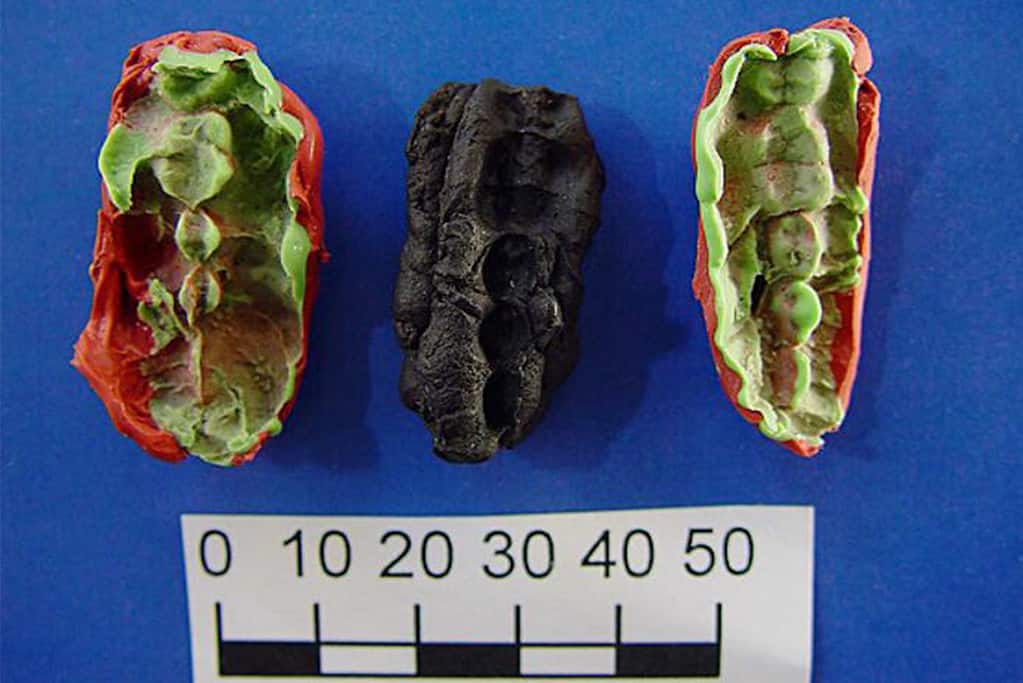
A team of European researchers studied prehistoric chewed pitch (chewing gum made from tree resin or pitch) found 30 years ago in Huseby Klev, a site near Gothenburg city in Sweden, alongside human remains. The ancient chewing gum has genetic material not only from humans, but also from birds, mammals, and numerous pathogens.
The three pieces of pitch have tooth imprints of the individuals who chewed them and are about 9,890 years old. That makes this the oldest chewing gum ever known.
The researchers conducted a detailed DNA analysis of the chewed pitch and recently published their findings, revealing interesting details about the diet, dental hygiene, and oral microbiome of Stone Age teenagers in Sweden.
“The chewed pitch material is an excellent source of ancient DNA, which can be used to understand diet, raw material use, and oral health conditions in prehistoric and early modern populations,” the researchers note.
What does the prehistoric chewing gum say?
Analysis of the pitch suggests that Stone Age adolescents consumed hazelnuts, trout, and deer before they put the chewing gum in their mouths. Their diet also included red fox, wolf, mallard, robin, tufted duck, and many other birds and mammals.
However, they also used their teeth to craft tools and clothes out of animal skin and body parts. It is possible that not every animal, whose DNA was found in the gum, was part of their diet.
Why they chewed the pitch is still unclear. Possibly, they either believed it had some health benefits, or perhaps they simply enjoyed chewing resin, according to the researchers.
The DNA from the tooth imprints on the chewing gum also helped the researchers identify oral health-related issues faced by the Stone Age teens. For instance, in one of the samples, they detected traces of 27 different bacteria connected to gum disease (periodontitis).
“We reconstructed several ancient bacterial genomes and found notable amounts of oral pathogens. Furthermore, we compared the microbial profile in chewed pitch mastic particles to modern human salivary microbiomes. Our results show that the bacterial profile is similar to modern periodontitis cases. The wider use of the teeth, as tools, likely increased the risk of collecting periodontitis-causing oral microbes,” the researchers said.
It is quite possible that a few teenagers would have experienced tooth loss due to gum infection soon after they developed the habit of chewing pitch.
Extracting information from chewing gum is tricky
Both boys and girls used to chew pitch. In 2019, with the help of the same chewed resin, the researchers also managed to sequence the full genome of individuals who chewed it. However, previous studies lacked information about the diet and oral health of the Stone Age teens.
This is because it’s easy to study one type of DNA, but when it comes to identifying and studying the genetic material of different species in a DNA mix, the process becomes very challenging.
To overcome this problem, the researchers employed statistics and machine-learning models. The latter also helped them in identifying pathogens associated with gum disease.
“We had to apply several computational heavy analytical tools to single out the different species and organisms. All the tools we needed were not ready to be applied to ancient DNA, but much of our time was spent on adjusting them so that we could apply them,” Andrés Aravena, one of the researchers and a Metagenomics expert at Istanbul University, said.
Although it took a lot of effort and time, the study reveals an interesting method for determining what people ate thousands of years ago and the oral diseases they faced.
The study is published in the journal Scientific Reports.









